Energy-Saving Tips for Industrial Refrigeration Systems
Introduction
Energy-Saving Tips for Industrial Refrigeration Systems are critical for maintaining the quality and safety of products in various industries, including food and beverage, pharmaceuticals, and manufacturing. However, these systems can be energy-intensive, leading to high operational costs and environmental impact. Implementing effective energy-saving strategies is crucial for reducing energy consumption, lowering costs, and improving overall system efficiency. This guide provides practical tips to help you optimize your industrial refrigeration system and achieve significant energy savings.
What is Industrial Refrigeration Systems?
An industrial refrigeration system is a complex network of components designed to remove heat from a specific environment or process, maintaining desired low temperatures for industrial applications. These systems are crucial for sectors such as food and beverage, pharmaceuticals, manufacturing, and chemical processing.
Types of Industrial Refrigeration Systems
1. Centralized Refrigeration Systems
Centralized systems are designed to provide cooling to multiple areas or processes within a facility from a single central unit. This unit typically includes all the major components needed for refrigeration, such as compressors, condensers, and evaporators.
2. Decentralized Refrigeration Systems
Decentralized systems consist of multiple self-contained refrigeration units installed near the areas they serve. Each unit operates independently, providing cooling to a specific zone or process.
3. Modular Refrigeration Systems
Modular systems are designed with interchangeable, scalable components that can be added or removed as needed. They offer flexibility and adaptability for varying cooling demands.
Regular Maintenance
- Routine Checks: Conduct regular inspections to ensure all components are operating correctly. Scheduled maintenance helps prevent unexpected breakdowns and keeps the system running efficiently.
- Cleaning: Regularly clean condenser and evaporator coils to prevent dirt buildup, which can hinder heat exchange and reduce efficiency.
- Leak Detection: Identify and repair refrigerant leaks promptly to minimize energy loss and maintain optimal system performance.
Use Variable Speed Drives (VSDs)
- Compressor VSDs: Install VSDs on compressors to adjust their speed according to the cooling demand. This helps reduce energy consumption during periods of lower demand.
- Fan VSDs: Implement VSDs on fans to control airflow based on load requirements, further optimizing energy use.
Implement Heat Recovery Systems
- Heat Recovery Units: Use systems that capture and repurpose waste heat from refrigeration processes for other applications, such as heating water, thereby improving overall efficiency.
- Heat Exchangers: Integrate heat exchangers to enhance heat recovery and utilization.
Enhance Airflow
- Clean Air Filters: Regularly clean or replace air filters to prevent airflow restrictions that can impact system performance.
- Maintain Ventilation: Ensure that air vents and cooling coils are unobstructed to facilitate effective heat dissipation and improve system efficiency.






